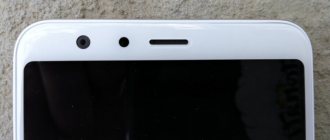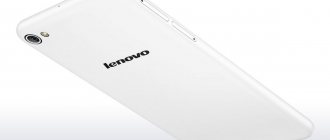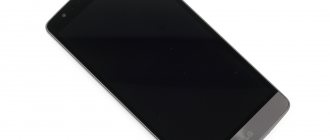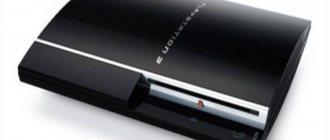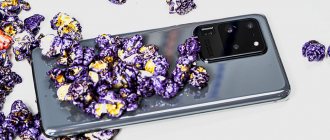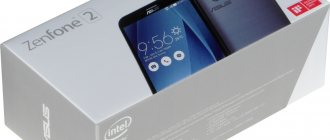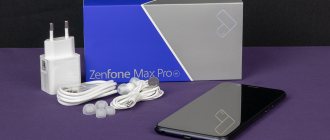Appearance and photos of the smartphone
Advantages and disadvantages of ZenFone 3 Max ZC520TL
The dimensions of the Asus ZenFone 3 Max ZC520TL are 73.7 mm wide, 149.5 mm long and 8.55 mm thick. With such dimensions it is convenient to operate the device with one hand. In addition, the weight of the device is about 148 g. Even if you operate the device with one hand, its weight is almost not felt.
If we evaluate the overall ease of use of the phone taking into account the size and weight, then there will be no problems with everyday use.
The smartphone is equipped with a 4-core MediaTek MT6737M processor, which is made at 28 nm. technical process.
The smartphone has 2 GB. RAM, which is quite enough. In very rare cases it will not be enough, but with this amount of RAM, you will rarely have problems.
The device's data storage capacity is 16 GB, and while this is enough for photos, it may not be enough for video shooting and a large number of games.
The phone is compatible with SD cards, so you can easily expand its memory. So you probably don't need to worry about storage capacity.
ZenFone 3 Max ZC520TL has a display diagonal of 5.2 inches. The display is large enough that you will rarely have problems with its size. However, this display is not suitable for writing long texts.
The smartphone has a high-end display and any graphic content you display on it, including videos and games, will be displayed clearly.
The main camera of the phone has 12.98 megapixels and can take high-resolution photos and videos. While you're shooting landscapes or printing high-definition photos, you may want a higher-resolution camera, but most of the time you'll be happy with the camera.
Also, the smartphone has a 4.98 megapixel front camera, which is average for smartphone cameras. This is good enough for taking selfies, but you may not be satisfied with group photos or their print quality.
The battery capacity of Asus ZenFone 3 Max ZC520TL is 4100 mAh, which is a very large indicator. Compared to other smartphones, the battery life of the Asus ZenFone 3 Max ZC520TL is very long. With such a capacity, you will be pleasantly surprised by the battery life. Even if you watch videos or play games for a long time, you will not have any problems with the battery.
Review of ASUS ZenFone 3 Max. Long-lasting smartphone
The line of ASUS ZenFone 3 smartphones is quite large, and there are several modifications for each model. To understand the entire model range, you have to carefully study the characteristics. This time we got a long-lived budget smartphone ZenFone 3 Max (ZC520TL) for testing.
The device is based on the MediaTek MT6737T system-on-chip, and a 5.2-inch HD display is responsible for displaying information. But the main feature of the smartphone is a battery with a capacity of 4130 mAh, which, according to the manufacturer, can ensure the smartphone operates in standby mode for 720 hours and 20 hours in talk mode. Considering the attractive price, this offer is quite interesting.
Specifications
| Display size and type | 5.2 inches, 1280x720 pixels, IPS |
| CPU | MediaTek MT6737T |
| Graphics accelerator | GPU Mali T720 |
| Built-in memory, GB | 16 |
| RAM, GB | 2 |
| Memory expansion | MicroSD up to 32 GB |
| Number of SIM cards | 2 |
| 2G communication standards | 850, 900, 1800, 1900 |
| 3G communication standards | 850, 900, 1900, 2100 WCDMA: Band: 1/2/5/8 |
| 4G communication standards | FDD: Band: 1/2/3/4/5/7/8/18/19/26/28 TD: Band: 38/41 |
| WiFi | 802.11b/g/n, 2.4 GHz |
| Bluetooth | 4,0 |
| NFC | No |
| IrDA | No |
| USB connector | microUSB |
| 3.5 mm jack | Eat |
| FM radio | Eat |
| Fingerprint's scanner | Eat |
| Navigation | GPS/A-GPS, GLONASS, BeiDou |
| Built-in sensors | Acceleration sensor, e-compass, proximity sensor, light sensor |
| Main camera | 13.0 MP, f/2.2 |
| Front-camera | 5.0 MP, f/2.4 |
| operating system | Android 6.0 with ASUS ZenUI 3.0 user interface |
| Protection class | No |
| Battery | 4130 mAh |
| Dimensions, mm | 149.5 x 73.7 x 8.55 |
| Weight, g | 148 |
Appearance
Unlike the main model of the line, ZenFone 3, the back of the tested smartphone is made of aluminum alloy with a smooth surface and a matte finish. The front side is covered with protective glass with a 2.5D effect. In general, despite its price, the smartphone does not look like a poor relative - the body is well assembled, does not creak when twisted, but when lightly tapping the body, the keys rattle a little.
The coating of the metal panel is of high quality, so even on the model from the press park, which had already gone through many editions during the testing period, no scratches or abrasions were noticed. In addition, fingerprints are completely invisible on the lid. The front side also turned out to be quite resistant, but prints on it are already noticeable. If there is an oleophobic coating, it is not the best.
On the front side in the upper part there is a camera, a sensor unit, and a speaker. There are no separate control keys on the front panel - the lower part of the display is dedicated to them.
On the back side at the top and bottom there are plastic covers that hide the antennas. Visually they resemble a metal surface, but are slightly darker. Plastic inserts and a metal lid are separated by a thin chrome edge. At the top there is a microphone, a fingerprint sensor and a camera unit that does not protrude above the surface of the smartphone. The fingerprint sensor, like the main ZenFone 3 model, is also slightly recessed, but larger, making it easier to use. Only the system speaker is visible at the bottom, and this is not the best installation location.
On the right side surface there are only volume control and lock keys. Traditionally for ASUS ZenFone smartphones, they are covered with barely noticeable circular notches.
On the left, only a hybrid tray is visible, one of the compartments of which allows you to install only a SIM card, and the second - a SIM card or a microSD memory card. Tray with pallet, making it easy to install tiny cards.
At the top end there is only a 3.5 mm mini-jack wired headphone connector, and at the bottom end there is a microUSB connector and a second microphone.
Software
The smartphone uses Android 6.0 OS and the proprietary ASUS ZenUI 3.0 shell, which was reviewed when testing the main model of the line - ASUS ZenFone 3. In this review, we will provide only screenshots.
This slideshow requires JavaScript.
Display
ASUS ZenFone 3 Max, depending on the modification, can be equipped with a 5.5" display or, like the tested smartphone, 5.2". A resolution of 1280x720 pixels by modern standards for a smartphone with a screen diagonal of more than 5” may seem insufficient, but in fact, you can only see individual pixels by burying your nose in the screen. The advantages of this resolution relative to Full HD are longer battery life and lower requirements for SoC performance. The display has an oleophobic coating, but the protective glass still needs to be wiped periodically. Viewing angles are quite large and colors are not inverted when viewed from an acute angle. When viewing the display for long periods of time, such as reading, you can activate the blue filter mode, which reduces eye strain.
When manually setting the maximum brightness of the backlight, the luminosity of the white field is 483.67 cd/m2, and the luminosity of the black field is 0.86 cd/m2. Static contrast ratio 562:1. Far from the best result, but quite sufficient for comfortable use. Automatic brightness adjustment works correctly and changes the backlight brightness level, but the response is slow. If there is a sudden change in lighting, the brightness of the backlight is adjusted only after 7-8 seconds. It would be much more convenient if the brightness change occurred slowly, over the same 7-8 seconds. The color temperature is a little high and rises sharply in dark tones. The color deviation Delta E depending on the color (RGBCMY) ranges from 3.5 to 7.6, and for shades of gray - as the luminosity increases, the deviation grows from 3.6 to 14.0. In principle, such values are acceptable for non-professional equipment. The color gamut is slightly out of sync with the sRGB color space.
This slideshow requires JavaScript.
Sound
The speaker is loud enough, the sound is clear and has no obvious flaws. The system speaker is placed on the back cover of the case, so when you place the smartphone on a flat surface, such as a tabletop, the sound volume drops significantly. But this arrangement of the speaker also has its advantages - the palm behind the speaker acts as a kind of acoustic chamber, which gives volume to the sound. When the volume is set to maximum, the speaker does not creak or choke, but the sound lacks even a hint of bass, and the high-frequency range is only slightly noticeable. The sound volume is low: when playing a sinusoidal signal with a frequency of 1 kHz at a distance of 1 meter from the smartphone, a level of 68.3 dBA was recorded. But it’s hard to expect more from a budget smartphone.
But the volume level on the analog output is very high, so much so that it can easily drive headphones with medium impedance. When applying a sinusoidal signal with a frequency of 1 kHz and operating at a load of 32 Ohms, a level of 567.6 mV was recorded. The sound is generally good, but testing in the Right Mark Audio Analyzer package was not possible due to non-disabled sound processing.
Performance
ASUS ZenFone 3 Max is based on the 64-bit MediaTek MT6737T SoC, which includes 4 Cortex-A53 cores and an ARM Mali-T720 MP2 video subsystem. This system-on-chip is made using a 28 nm process technology. In general, this is an ordinary budget solution, even if it was introduced not so long ago. The amount of RAM in the tested modification is 2 GB, and the memory type, of course, is LPDDR3. The ROM in the tested smartphone is only 16 GB.
This slideshow requires JavaScript.
System performance was measured using synthetic PCMark, 3DMark, Geekbanch 4 and AnTuTu v6. Memory speed was assessed using the AndroBench application.
Testing was also carried out in cross-platform javascript tests (Mozilla Kraken JavaScript and SunSpider). The results of these tests significantly depend on the browser used, therefore, to minimize the impact, Google Chrome will be used in all reviews, as the most common one.
The system performance is sufficient to run any game, but for resource-demanding games, the display quality settings have to be changed to the minimum, and the most demanding games slow down even with these settings.
Camera
It was not possible to determine the sensor model of the front and main cameras. The 5 MP front camera with f/2.4 aperture is capable of providing acceptable quality only in good lighting. With normal lighting in a living space (about 100 lux), the pictures turn into a complete mess. The main camera is 13 MP with f/2.2 aperture. You can’t really find fault here, because even some flagships have similar aperture openings. There is no laser or phase detection autofocus here, but focusing is fast, although not always accurate. In good lighting, the camera allows you to take good pictures, and even in low light the quality is quite tolerable. The flash is based on a single LED, which at a distance of 1 meter provides 16.8 lux of illumination, and this is a rather modest result.
This slideshow requires JavaScript.
Unfortunately, transferring camera control using the Camera 2 API is not supported, shooting in RAW is also not available, so assessing the level of the matrix’s own noise is impossible, or rather makes no sense due to the noise reduction. To evaluate image quality, a test pattern was captured with all available sensitivity values. Below are cropped fragments.
Sample pictures
Macro photography
Shooting in low light
| Illumination 50 lux | Illumination 50 lux + flash | Illumination 3 lux + flash |
To evaluate the resolution, it was decided to add shooting of a test pattern under different lighting conditions. The shooting was carried out at illumination of 1000 lux, 20 lux and 3 lux with flash. Based on the resulting images, the resolution was determined in cycles per pixel (one cycle is one dark and one light line) in the central part of the frame (MTF50).
In video mode, there are no revelations - video recording in 1080/30p mode. Electronic video stabilization is provided only when recording HD videos. Autofocus works in video recording mode.
Autonomous operation
One of the main features of a smartphone is, of course, its battery and autonomous operation. The battery capacity is 4130 mAh, while the SoC and display have relatively low power consumption. The manufacturer promises that the smartphone can work for 720 hours (1 month) in idle mode, and 20 hours in talk mode. The energy saving settings provide 4 energy saving plans plus one customizable one. It is also possible to activate an automatic transition to super-economy mode when a certain charge level is reached (10, 15, 20, 25 or 30%). Switching to economy mode is also possible according to a schedule, for example, at night. Another interesting feature is that it works as a mobile battery. When connecting the OTG cable, the system asks you to select the operating mode: PowerBank or OTG. In our battery life testing scenarios, the smartphone showed unimpressive results, but it does last a very long time in standby mode.
Conclusion
ASUS has produced a high-quality smartphone that looks expensive, but the hardware is budget-friendly. In principle, there is enough performance for any modern task, but this smartphone is clearly not for “heavy” games. The installed cameras are quite simple, but still the quality is not bad for its class. The main feature of the smartphone is its capacious battery. But, unfortunately, the test results did not show impressive battery life results. An ordinary smartphone has a long life, but nothing more. But the ability to charge other devices from the built-in battery is a plus for the smartphone.
Cons: – low performance; – weak camera; – weak flash; – lack of electronic stabilization when recording Full HD video. Pros: – high-quality materials and assembly of the case; – good display; – fairly long battery life in standby mode and at low loads; – the ability to charge devices from the smartphone being tested.
If you find an error, please select a piece of text and press Ctrl+Enter.
- Click here to share content on Facebook. (Opens in a new window)
- Click to share on Twitter (Opens in new window)
- Click to share on Telegram (Opens in new window)
- Click to share on Reddit (Opens in new window)
- Click to share posts on Pocket (Opens in new window)
- Click to share on Skype (Opens in new window)
- Click to print (Opens in new window)
Detailed technical specifications
Make and model
Make and model of the device, and alternative names (if any).
| Brand Device manufacturer company. | Asus |
| Model Device name. | ZenFone 3 Max ZC520TL |
| Alternative names Other model names, if available. Sometimes the model is called differently, depending on the country or because of popular nicknames. | ZC520TL |
Design
Appearance of the device including dimensions, weight, volume, colors and materials.
| Width The horizontal side of the device when used in standard orientation. | 73.7 mm (millimeters) |
| Height The vertical side of the device when used in standard orientation. | 149.5 mm (millimeters) |
| Thickness The cross-sectional size of the device. | 8.55 mm (millimeters) |
| Weight How much does the device weigh excluding the case, SIM and memory cards and other additional elements. | 148 g (grams) |
| Volume Approximate value calculated using the formula: length times width times height. | 94.21 cm³ (cubic centimeters) |
| Colors What colors is the device available in? | Gray Silver Golden |
| Housing materials What materials is the body made of? | Metal |
System on a Chip (SoC)
A system on a chip, a single-chip system (System on a Chip, SoC) is when several systems performing different device functions are connected on one chip.
| System on a Chip (SoC) A single-chip system that contains components such as a processor, graphics accelerator, memory units, communication interfaces, etc., as well as software for the operation of the system. | MediaTek MT6737M |
Central processing unit (CPU)
| Central processing unit (CPU) The main component of the device is responsible for calculations and data processing. | ARM Cortex-A53 |
| Technical process What technological process is used to make the chip? The smaller the process technology, the better - the chips consume less power and generate less heat. | 28 nm (nanometers) |
| Processor size Processor capacity is a parameter that indicates how many bits of data a processor register processes in 1 clock cycle. This is usually 32 or 64 bits. | 64 bit |
| Instruction Set Architecture Instruction set architecture (ISA) is a programmable part of the microprocessor core used by software to control the operation of the processor. | ARMv8-A |
| Number of processor cores The processor can be either single-core or multi-core. The performance of the processor depends on the number of cores (threads). The more cores working simultaneously, the higher the power consumption, so in mobile devices all cores are used only under high load. | 4 |
| CPU clock speed Clock speed is the number of operations per second that a processor or its core can achieve. The higher the frequency, the higher the overall performance of the device, but performance also depends on the processor architecture and the number of cores. | 1250 MHz (megahertz) |
Graphics Processing Unit (GPU)
| Graphics Processing Unit (GPU) The graphics processing unit (GPU) is used to process and display graphics - 3D effects, games, interfaces and other visual elements. Due to the pipeline architecture, the GPU is many times more efficient in graphics processing than the processor. | ARM Mali-T720 MP1 |
| Number of GPU cores Similar to a processor, a GPU can have one core or several. The number of cores (threads) determines the performance and amount of information processed. The more cores, the better. | 1 |
| GPU clock speed Clock speed is the number of operations per second that the GPU or its core is capable of achieving. The higher the frequency, the higher the speed of the processor, and therefore the number of tasks it can solve. | 550 MHz (megahertz) |
Random access memory (RAM)
| Amount of random access memory (RAM) RAM (Random Access Memory, RAM, RAM) is temporary memory (works only while the device is running), which stores data and code for the operational operation of programs and applications. The more RAM, the more programs you can run simultaneously without loss of performance (there will be fewer “brakes”). | 2 GB (gigabytes) 3 GB (gigabytes) |
| Type of random access memory (RAM) Information about the type of RAM used by the device. | LPDDR3 |
| Number of RAM channels 1 is a single-channel RAM operating mode, basic, when 1 memory module is used. 2 is already a two-channel mode - a mode of parallel operation of 2 modules or pairs of modules, memory channels - this mode is 2 times faster than a single-channel one. 3 – three-channel mode is 3 times faster than single-channel mode. | Single channel |
| RAM frequency The frequency of RAM determines the speed of RAM, or rather the speed of data transfer and reception. In theory, the higher the frequency, the more powerful the RAM. | 640 MHz (megahertz) |
Built-in memory
Most mobile devices have built-in Flash memory, which is used as a storage for system data, the operating system, as well as user data - photos, videos, recordings and much more.
| Built-in memory capacity The higher the amount of built-in memory, the more games, programs, music, videos and your other files will fit in the device, especially the amount of memory is important when the device does not support memory cards. | 16 GB (gigabytes) 32 GB (gigabytes) |
Operating system
A mobile operating system (OS) is pre-installed software with a well-thought-out interface for user control of device functions.
| Operating system (OS) The operating system installed by default by the device manufacturer, as well as its version. | Android 6.0 Marshmallow Android 7.1.1 Nougat |
| User interface User interface (UI - user interface) is usually a graphical shell that ensures the transfer of information between the user and the operating system. | ZenUI 3.0 |
Battery
To operate autonomously, a mobile device requires a battery that powers all its components.
| Battery capacity The main characteristic of a battery is its maximum capacity, that is, the charge it can store. Capacity is measured in mAh (mAh, milliamp-hour). The higher the capacity, the longer the mobile device can work. | 4100 mAh (milliamp-hours) |
| Battery type Many types of batteries have been used in portable devices, but NiCd (nickel-cadmium), NiMH (nickel-metal hydride), and even more so SLA (lead-acid) batteries are already considered obsolete. Instead, modern mobile devices use Li-Ion (lithium-ion) and Li-Pol, Li-Poly (lithium-polymer) batteries. | Li-polymer |
| Power adapter Characteristics of the charger (adapter, power supply) included in the standard package of the mobile device. More precisely, the output voltage in volts (V) and the output current in amperes (A). | 5 V (volts) / 2 A (amps) |
| Call duration on 2G network (GSM, CDMA) Approximately how long will it take for a fully charged battery to discharge when talking in 2G mode. Approximate, because this time is influenced by many factors, such as the operator, signal strength, active applications, and so on. | 20 h (hours) 1200 min (minutes) 0.8 days |
| Waiting time on 2G network (GSM, CDMA) Approximately how long will it take for a fully charged battery to discharge if the mobile device is not used and is connected in 2G mode. | 720 h (hours) 43200 min (minutes) 30 days |
| Call duration on 3G network (WCDMA, UMTS, CDMA2000) About how long a fully charged battery will be discharged during a call on third generation networks. Approximate time because it is influenced by various factors, including ambient temperature. | 20 h (hours) 1200 min (minutes) 0.8 days |
| Waiting time on 3G network (WCDMA, UMTS, CDMA2000) About how long a fully charged battery will be discharged if the mobile device is in standby mode and connected to third generation networks. | 720 h (hours) 43200 min (minutes) 30 days |
Screen
The screen (display) is the main element for displaying graphic information.
| Technology The technology used to make the screen. There are many types of display manufacturing with their pros and cons. | IPS |
| Diagonal The screen diagonal of a device is measured in inches (inch, in or simply ″), and 1″ is equal to 2.54 cm. | 5.2 in (inches) 132.08 mm (millimeters) 13.21 cm (centimeters) |
| Width Approximate screen width | 64.75 mm (millimeters) 6.48 cm (centimeters) |
| Height Approximate screen height | 115.12 mm (millimeters) 11.51 cm (centimeters) |
| Aspect Ratio Aspect ratio is the ratio of the shorter side of the screen, which is considered to be 1, to the longer side, which is denoted by a decimal fraction indicating the ratio to the short side. | 1.778:1 16:9 |
| Screen resolution Screen resolution is the number of horizontal pixels (dots) multiplied by the number of vertical pixels. The higher the resolution, the more detailed the image will be. | 720 x 1280 pixels |
| Pixel Density The number of pixels per inch or PPI (pixels per inch) indicates the density of pixels per 1 inch (2.54 cm) of the screen. The higher the PPI, the sharper the image, and the less visible or even invisible “squares and dots” (pixels). | 282 ppi (pixels per inch) 110 ppcm (pixels per centimeter) |
| Color depth Color depth means how many bits are used in 1 pixel to display color (bits per pixel). | 24 bit 16777216 colors |
| Screen area Approximate usable area occupied by the screen on the front of the device. The higher the percentage, the narrower the frames around the display or the smaller the “chin with bangs.” | 67.87% (percent) |
| Touch screen A touch screen is a device that usually covers the display and is a touch input tool. In fact, in mobile devices, the touchscreen is a replacement for the keyboard and mouse. | Yes |
| Touch screen type There are many types of touch screens, with their pros and cons. Mobile devices often use capacitive touchscreens, but technology does not stand still and new types of sensors are appearing. | Capacitive |
| Multi-touch Touch screen support for two or more touches. For example, zooming photos with two fingers. | Yes |
| Brightness Screen brightness is measured in candelas per square meter (cd/m2, cd/m2). The higher this indicator, the brighter the screen luminosity will be and the less it will be affected by ambient lighting. Comfortable brightness for videos and games is considered to be 300 cd/m2 or more. | 400 cd/m² |
Main camera
The main camera, usually built into the rear of the device, is designed for creating photo and video content.
| Maximum image resolution This is the maximum number of pixels (dots) horizontally and vertically. The higher the resolution, the more detailed the image will be. Resolution can also be indicated in megapixels - this is the total number of pixels that can be in the image, calculated by the formula: vertical pixels multiplied by the number of horizontal pixels and divide the resulting amount by 1 million. | 4160 x 3120 pixels 12.98 MP (megapixels) |
| Matrix type There are two main types of photomatrix, CCD (Charge-Coupled Device) and CMOS (Complimentary Metal-Oxide Semiconductor). Mobile devices mainly use a CMOS matrix - it requires less space, has low power consumption and heating. Recently, new types of sensors have begun to appear, for example PureCel from OmniVision. | CMOS (complementary metal-oxide semiconductor) |
| Diaphragm Aperture (f-number, f) is used to control the light flux passing through the lens. The aperture is indicated by a fraction, and the smaller the fractional number, the higher the aperture passing through the lens. The more light that passes through the lens, the better overall, less noise in your photos and better night photography. | f/2.2 |
| Flash type Most mobile devices are equipped with light-emitting diode (LED) flashes, but there are also xenon flashes. As a flash, xenon is better - it is more powerful, but LED is more versatile (can work as a flashlight) and consumes less electricity. | LED |
| Maximum video resolution This is the maximum number of pixels (dots) horizontally and vertically. The higher the resolution, the more detailed the image will be. | 1920 x 1080 pixels 2.07 MP (megapixels) |
| FPS video recording at maximum resolution FPS (Frames per Second, frame rate) is the number of frames that changes in 1 second. The higher the number of frames per second, the smoother the image will be. In this case, we mean the number of frames that the camera can achieve at its maximum resolution; the lower the resolution, the higher the FPS can be. | 30 fps (frames per second) |
| Presence of flash Incorporating a flash into a mobile device allows you to take pictures in low light conditions. Creates the necessary lighting and compensates for the lack of natural light. | Yes |
| Digital zoom With digital zoom (zoom, enlargement), the subject is brought closer due to software image algorithms. The higher the magnification with digital zoom, the worse the image quality (noise, blur) will be compared to a non-zoomed one. | Yes |
| Number of lenses in the lens This is the number of optical elements (lenses) that are contained in the optical circuit of a camera lens. | 5 |
| Focus on face Function of auto-detection of living objects and autofocus on their face or head. | Yes |
| Panoramic shooting mode Panoramic photography is a series of frames where each subsequent frame is a continuation of the previous one; at the end of the shooting, all frames are stitched together at the software level to create a panoramic photograph. Frames can be shot both vertically and horizontally, and their width can be up to 360 degrees. This type of shooting is used when the camera's viewing angle is not enough to capture the entire scene. | Yes |
| HDR shooting mode HDR photography takes a quick series of shots with highlights, midtones, and shadows, then combines them into a single frame with high dynamic range. | Yes |
| White balance White balance is a setting that helps ensure the correct color reproduction in an image by determining the color temperature of the light source in the frame. The balance can be set either automatically or manually. | Yes |
| ISO Setting ISO is the level of light sensitivity. The lower the ISO, the less sensitive the camera's light sensor and the smoother the image with less noise. The higher the ISO, the higher the light sensitivity, but more noise, graininess, or decreased sharpness. | Yes |
| Additional Information Additional information about the functions and characteristics of cameras. | Autofocus Continuous shooting Geo-tagging Touch focus Exposure compensation Self-timer Scene select mode |
Front-camera
The front camera of a mobile device (selfie camera, rear camera) is a camera on the front part, which is usually used for video communication, recognition of gestures or faces, and selfie photographs.
| Photo resolution The maximum image resolution that the camera can produce. As resolution increases, image detail increases. Resolution can also be indicated in megapixels (the total number of pixels that an image can consist of) - these are vertical pixels multiplied by horizontal pixels and divided by 1 million. | 2592 x 1920 pixels 4.98 MP (megapixels) |
Memory card
A memory card (flash card) is an external data storage device that is used in many devices to increase memory capacity.
| Memory card type and formats Mobile devices usually use 3 types of memory cards - SD, miniSD and the most common microSD. Each type has its own formats that the device supports. | microSD microSDHC |
SIM card
Subscriber Identification Module (SIM) used in mobile devices to identify subscribers in cellular networks.
| Type, size of SIM card A regular (mini SIM) card has dimensions of 25x15 mm. Micro SIM - 15x12 mm. Nano SIM - 12.3x8.8 mm. The sizes of SIM cards are different and not interchangeable. There is also an eSIM (virtual, electronic SIM card), it is built into the device and does not take up space. | Micro-SIM (3FF - third form factor, since 2003, 15.00 x 12.00 x 0.76 mm) Nano-SIM / microSD |
| Number of SIM cards How many SIM cards does the device support? | 2 —- SIM1 — 2G; 3G; 4G SIM2 - 2G; 3G; 4G |
Mobile networks
This is a system in which communication and data transfer is carried out between subscribers, the location of one or more of which changes. This section lists the supported mobile communication standards and frequencies.
| GSM GSM (Global System for Mobile Communications) is a standard for digital mobile cellular communications of the second generation 2G with time and frequency division of channels. GSM came to replace analog cellular communications 1G (first generation). | GSM 850 MHz GSM 900 MHz GSM 1800 MHz GSM 1900 MHz |
| TD-SCDMA TD-SCDMA (Time Division Synchronous Code Division Multiple Access) is a third generation (3G) mobile communications standard used in China. | TD-SCDMA 1880-1920 MHz (CN) TD-SCDMA 2010-2025 MHz (CN) |
| UMTS UMTS (Universal Mobile Telecommunications System), also called 3GSM, is a third generation (3G) mobile communications standard based on the WCDMA air interface. | UMTS 900 MHz UMTS 2100 MHz UMTS 850 MHz (B6) (TW;JP) UMTS 1900 MHz 9 CN; TW; JP; WW) UMTS 800 MHz (B19) (TW; JP) |
| LTE LTE (Long-Term Evolution, often referred to as 4G LTE) is a standard for wireless high-speed data transmission, which, although it belongs to fourth generation networks (4G), is essentially a transitional stage from 3G to 4G, greatly accelerating data transfer speeds. The standard has an improved version, LTE Advanced (LTE-A), which can already be considered a full-fledged 4th generation network. | LTE 900 MHz LTE 1800 MHz LTE 2100 MHz LTE-TDD 1900 MHz (B39) (CN) LTE-TDD 2500 MHz (B41) (CN; TW; JP) LTE-TDD 2600 MHz (B38) (CN; TW; JP) LTE-TDD 2300 MHz (B40) (CN; IN; ID) LTE 850 MHz (IN; ID; TW; JP) LTE 1900 MHz (TW; JP) LTE 1700/2100 MHz (TW; JP) LTE 2600 MHz (CN ; TW; JP) LTE 800 MHz (B18) (TW; JP) LTE 800 MHz (B19) (TW; JP) LTE 850 MHz (B26) (TW; JP) LTE 700 MHz (B28) (TW; JP) |
Mobile network data standards
What data transfer standards in cellular networks are supported by the device, as well as their speed.
| Data transmission technologies Technologies for receiving and transmitting data, as well as their maximum speed. | UMTS (384 kbit/s) EDGE GPRS HSPA+ (HSUPA 5.76 Mbit/s, HSDPA 42 Mbit/s) LTE Cat 4 (51.0 Mbit/s, 150.8 Mbit/s) TD-SCDMA TD-HSDPA |
WiFi
Wi-Fi (Wireless Fidelity) is a technology for wireless data transmission over a local network among devices based on IEEE 802.11 standards.
| Wi-Fi Direct support The Wi-Fi Direct protocol allows multiple devices to connect directly, bypassing the use of routers or access points. | Yes |
| Wi-Fi Hot-Spot A hotspot is a Wi-Fi access point. In a mobile device, Hot-Spot turns the smartphone into a Wi-Fi access point, essentially turning it into a router capable of distributing the Internet. | Yes |
| WiFi Supported WIFI wireless network standards. | 802.11b (IEEE 802.11b-1999) 802.11g (IEEE 802.11g-2003) 802.11n (IEEE 802.11n-2009) |
Bluetooth
Bluetooth (BT, bluetooth (z), “blue tooth”) is a short-range wireless network (up to 10, sometimes 100 meters) operating on radio waves to transmit voice and data between devices.
| Bluetooth version Bluetooth technology is actively developing and, since 1998, has been constantly updating versions of the standard. Each subsequent version introduces one or several improvements in data exchange speed, range, facilitates pairing, reduces power consumption, or introduces some new protocols and operating profiles. The higher the Bluetooth version, the better. The technology is also backward compatible, for example, if your mobile device has version 5.0, then it will work with accessories version 4.2 and lower, but the improvements introduced in version 5.0 will not work; they will work only if both the device and accessories are version 5. | 4.0 |
| A2DP profile The A2DP Bluetooth profile is designed to transmit a high-quality two-channel stereo signal via Bluetooth to wireless headphones, speakers and other acoustics. | Yes |
Sensors
Modern devices have many sensors that help in measurements, trigger functions, and make using the device more pleasant.
| Light sensor The light sensor reacts to the light level and is able to adjust the screen brightness automatically based on this. This is necessary to reduce power consumption and ease of use of the device. | Yes |
| Proximity sensor The proximity sensor reacts to the proximity of the mobile device to some object. For example, the sensor is used when talking on the phone to turn off the screen, which saves energy and prevents you from pressing buttons with your ear or cheek. | Yes |
| Accelerometer An accelerometer is a sensor that measures apparent acceleration, that is, it determines the position and distance at which a mobile device moves in space. Based on the data from this sensor, the screen orientation change, pedometer, control using tilts and gestures in games and applications, etc. work. | Yes |
| Fingerprint's scanner The scanner is responsible for authorization using a previously saved fingerprint, as a result of which the device is unlocked, payment is made, some action is confirmed - just put your finger on the scanner. Scanners can be either built into the body or built into a button or screen. | Yes |
| Additional sensors |
Audio
Audio - characteristics and capabilities of a mobile device in terms of sound.
| Music speaker There are two types of speakers in mobile devices - auditory and musical. The auditory speaker (speaker) is used for conversation, the music speaker (buzzer) is used to play music and sounds. | Loudspeaker Earphone |
Radio
The radio in a mobile device can be built-in by the manufacturer (catch local radio channels, no internet required, often works only with headphones (as an antenna), but not always) or installed as an online application (requires internet, but more channels and often better quality) .
| Built-in radio Is a radio tuner integrated into the mobile device? | Yes |
Navigation and location
The location is determined by satellite navigation systems that track the device's autonomous geospatial location at multiple points. The most common satellite navigation systems are GPS, GLONASS, and the Chinese BeiDou.
| GPS GPS (Global Positioning System) is a global satellite navigation system that can determine the position of a mobile device, build routes and find the desired object on the map with an accuracy of several meters. | Yes |
| A-GPS A-GPS (Assisted GPS) is an assistive technology that will help you quickly find the location of your cellular device without waiting for satellite data, which is especially important in indoors and cities. Location is determined in various ways, for example, Wi-Fi access points, mobile towers, bluetooth and others. | Yes |
| Additional navigation systems |
USB connector
USB (Universal Serial Bus) is a serial interface for connecting peripherals to computers, smartphones, laptops and much more. The interface allows you to exchange data and power a peripheral device with energy, as well as connect several peripheral devices to one USB connector at once.
| Connector type What type of USB connector is used in the device. | Micro USB |
| USB standard The higher the standard, the faster the throughput, or more precisely the data exchange rate. With version 3.0 of the standard, the current was increased to 0.9A, eliminating the need for additional power for some devices. | 2.0 |
| USB Mass Storage Connecting a mobile device via USB as a data storage device. That is, when you enable this mode, your device can be used as a flash drive. | Yes |
| USB OTG support OTG is the ability to connect peripherals, such as keyboards and mice, flash drives, card readers, and much more, to the USB port of your device via an adapter or directly. You can connect devices that do not require specialized drivers or additional power. | Yes |
| Additional characteristics Additional features of the USB connector, for example, OTG, whether the connection is supported, peripheral devices and additional memory. | Charging via USB |
Headphone jack
A TRS headphone jack (or jack) is a common standard of connectors used for transmitting audio signals. By diameter there are jack (6.5 mm), mini-jack (3.5 mm) and micro-jack (2.5 mm). In mobile devices, the 3.5mm jack was considered the most popular and widespread, but recently they began to be removed, leaving only USB connectors, through which headphones are connected with a corresponding plug or using adapters.
| 3.5mm headphone jack Does the device have a 3.5 mm audio jack? | Yes |
Connection and synchronization
Options for synchronizing your mobile device and connecting it to other devices.
| Connection, synchronization Types of synchronization and connection technologies supported by the device. | Computer sync OTA sync Tethering |
Browser
A browser is a browser program for viewing sites and their content on the Internet. Through the browser, you can open websites, search for information, download necessary files, watch streaming videos, play browser games, etc.
| Technologies Markup and programming languages supported by the built-in (standard) browser. For mobile devices, you can install additional browser applications if the standard one does not suit you. | HTML HTML5 CSS 3 |
Audio file formats/codecs
Mobile devices support many audio file formats, as well as codecs for playing them.
| Default formats The formats that the mobile device supports out of the box are indicated. But if the device does not support the format you need, then you can try adding support for it. Sometimes support depends on the technical characteristics of the device (“hardware”) and nothing can be added here, but often the ability to process a particular audio format depends on the software part. You can install another audio player or codec set separately. | AAC (Advanced Audio Coding) AAC+ / aacPlus / HE-AAC v1 AMR / AMR-NB / GSM-AMR (Adaptive Multi-Rate, .amr, .3ga) AMR-WB (Adaptive Multi-Rate Wideband, .awb) eAAC+ / aacPlus v2 / HE-AAC v2 FLAC (Free Lossless Audio Codec, .flac) MIDI MP3 (MPEG-2 Audio Layer II, .mp3) OGG (.ogg, .ogv, .oga, .ogx, .spx, .opus) WMA (Windows Media Audio, .wma) WAV (Waveform Audio File Format, .wav, .wave) |
Video file formats/codecs
Video file formats that the device supports and is capable of decoding and playing.
| Default formats Video file formats that the device is capable of playing with standard firmware and a standard (built-in) set of programs. Not all formats are supported by default, but you can install a third-party video player and/or set of codecs. | 3GPP (3rd Generation Partnership Project, .3gp) AVI (Audio Video Interleaved, .avi) MKV (Matroska Multimedia Container, .mkv .mk3d .mka .mks) MP4 (MPEG-4 Part 14, .mp4, .m4a, .m4p , .m4b, .m4r, .m4v) WebM WMV (Windows Media Video, .wmv) Xvid |
Display
Our hero received a 5.2-inch IPS matrix with a resolution of 1920 x 1080 pixels. The dot density is quite high - 424 ppi. Thus, loose fonts and pixelation are not easy to detect. You need to have good eyesight, peer from a very close distance and maybe you will see something.
The screen brightness has a good margin of 600 cd/m². The most important thing is that the automatic backlight adjustment always works correctly. Does not slow down, sets a comfortable level for the eyes. There is no need to manually adjust the backlight strip.
Considering that we have an IPS matrix in front of us, the viewing angles are good. Below we compare the screens of two devices: Asus Zenfone 3 (top or left in the photo) and LeEco Le 3 Pro (bottom or right).
In terms of color rendering, the device from LeEco is a little ahead, as it seemed to me. However, at extreme viewing angles, Zenfon outperforms its competitor - it does not have such a pronounced whitish fog.
